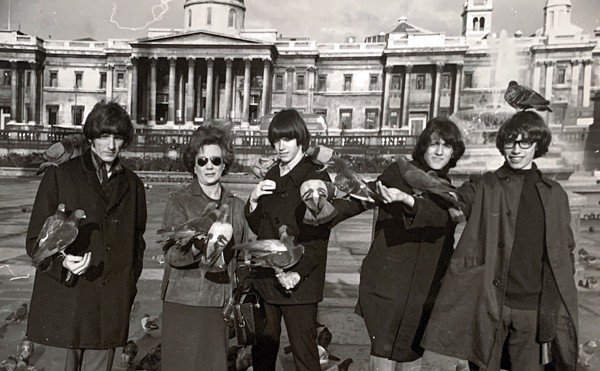Oh yeah -- he's closing the gap on his Ph.D. in psychology.
"If anything, we impose certain rules on ourselves in order to break ourselves of the rules found in so much other music. They're sets of rules that people follow without knowing they're following them," says O'Connor. "The trick is to break that unconscious habit of dealing with everything in terms of certain chord progressions or number of repetitions."
"You know, when you go see a band and it's like forty-five minutes of the same song, it's kind of taxing on the mind," sighs Jeremiah Wonsewitz, one of two guitarists who round out the Yowie roster with O'Connor. "It's like, 'Are they playing a different song? They stopped for a second, but...'"
Ironically enough, Yowie can sound like a lot of the same stuff if you're not paying attention. This seeming repetition owes largely to the way the human mind processes dissonance, a constant theme in the band's sound. Most of all music is based on harmonic tonal ratios. That is, the distances between notes are even and relative to an even division of the octave (Western music relies on a twelve-tone scale). Those distances between notes, measured as the ratio of their pitches, are known as intervals, and the human ear has historically heard simple ratios as euphonious, pleasant and easily comprehended. But the octave can be divided infinitesimally. When the ratio between two sounding notes involves a complex integer, a fluttering, usually imperceptible "beat" effect is produced. This is dissonance, and it's generally registered as unpleasant and unmusical to the ear.
Yowie happens to be one of those acts that ignores the unpleasantness and utilizes a greater number of intervals within the octave. The result is a microtonal sophistication in the music that requires close attention in order to discern the varying contrasts between notes. Fun, huh? It gets better.
"Sometimes we'll have a riff that we process through a string of numbers," says guitarist Jim Hagerty. "We have a chalkboard that we fill up with numbers."
The chalkboard Hagerty mentions is a three-by-six slate tablet of codes and sequences that takes up an entire wall of the band's tiny rehearsal room in the basement of O'Connor's north county home. At first glance, the dizzying array of integers looks like the obsessed scrawling of a schizophrenic who has abandoned medication and seeks comprehension of the godhead through abstract mathematic esoterica. In reality, the numbers represent the stymieing rhythmic patterns that Yowie seems to exercise effortlessly. After some scrutiny, one of several themes to arise from the nimbus of chalk trails is the absence of the number four.
"We do not like the number four. It is the most abused number of all time," states Wonsewitz gravely. "If you hear a four [used in our music], it's there by accident."
The number four happens to be the most common structural element in all music. It's used ad nauseam to designate rhythmic meter and frequency of repetition, and human beings have grown quite used to its presence. It can be argued that arranging music in fours can enhance its potential popularity because the human brain quickly parses the structures created. It's also easy to dance to music based on fours.
"We did have one [song] with a four in it for, like, a year, but we changed it. That was the last four," says Hagerty.
"We also play around with geometric relationships between parts; we've done a little with randomly generated numbers, too," adds O'Connor. "We'll try to order the chaos by imposing a structure upon them [within the context of the music]. Sometimes they don't seem like they go together well at all, and we force ourselves to make them work."
In the band's three-year history, Yowie seems to have done everything in its reach to make things as difficult on itself as possible. It is in this constant self-challenge that one can see a sort of intellectual nobility shining through songs that often sound as if they'll spin out of control and whiz off into the ether. O'Connor's drumming is a befuddling barrage of 32nd notes, jarring stops and cymbal splashes that defies simple description, often calling to mind the rhythmic mayhem of the music of Raymond Scott, the composer of scores for countless cartoons from the 1940s. And the dueling, microtonally tuned guitars of Wonsewitz and Hagerty engage in sonic relationships that don't seem to want to exist, often creating dissonance that's oddly compelling. It's high-velocity music of intense discipline, rigid structure and focused force; Yowie's kung fu is very good. The aural ass-whupping they so effortlessly throw down energizes, excites and amazes further with every listen. It's an ululating tribute to human potential through music, a testament to the fact that we as humans have much further to go. If music is the history of the human spirit, Yowie proves that musicians could start being a little more honest with themselves by seeking out every remote nook and cranny in the mind and bathing the darkness in an unrelenting light.
If it's possible to explain Yowie in one sentence, Hagerty has at least come close, if not nailed it beautifully.
"The point is to free the material and the given tools from each other."





